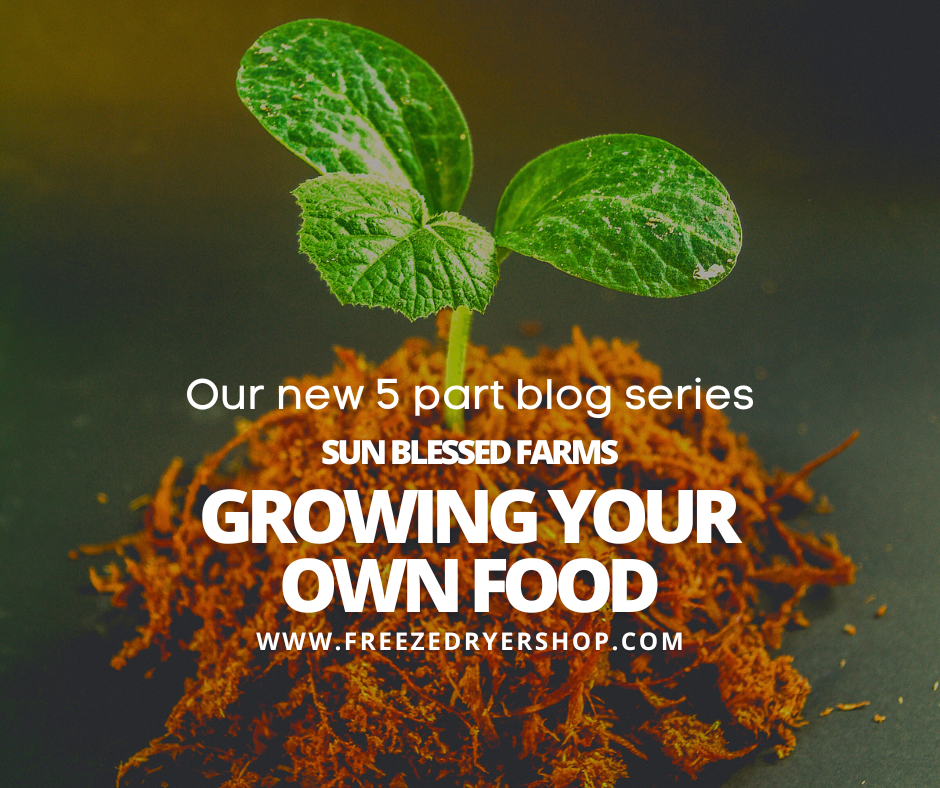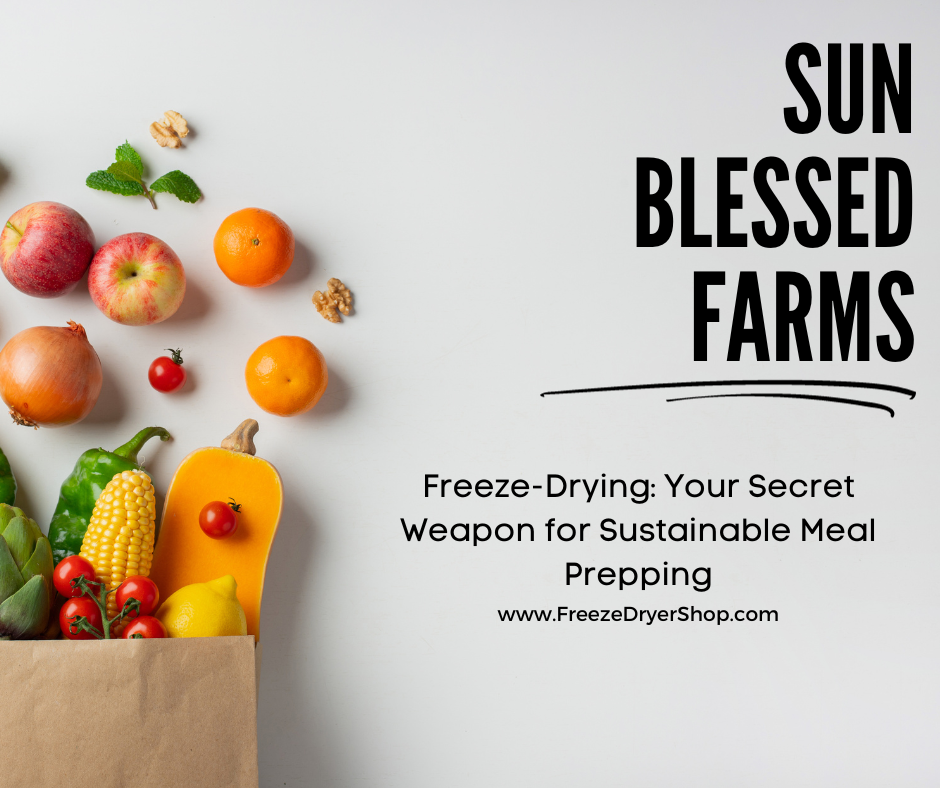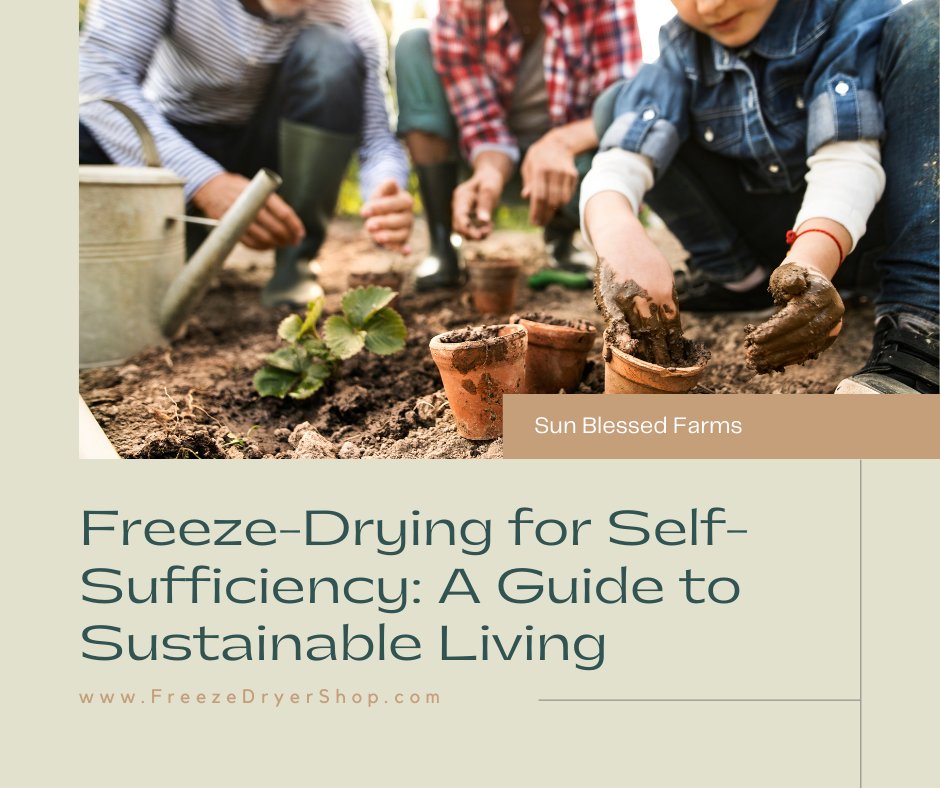Free Shipping to the lower 48 on all freeze dryers!

Please expect up to 4-6 weeks for your order to ship.
Growing Your Own Food Part 5
Preserving Your Garden Harvest: The Ultimate Guide
Welcome to the fifth and final installment of our "Growing Your Own Food" series, where we've explored various aspects of cultivating a thriving garden. In this blog post, we'll delve into a crucial topic that completes the circle of self-sufficiency and sustainable living—preserving your garden harvest.
Homegrown fruits and vegetables are a source of pride for gardeners, offering a bounty of flavors, nutrients, and satisfaction. However, as any experienced gardener knows, the abundance of the harvest season often exceeds what can be consumed fresh. That's where preserving techniques come into play.
Preserving your garden's bounty allows you to enjoy the taste of summer all year long, reduce food waste, and maintain a more sustainable and self-sufficient lifestyle. In this comprehensive guide, we'll cover ten key aspects of preserving your garden harvest, ensuring that none of your hard-earned produce goes to waste.
The 10 Key Bullet Points We'll Cover:
- Harvesting at Peak Ripeness: Learn the importance of harvesting your fruits and vegetables at the peak of ripeness for the best flavor and nutritional content.
- Selecting the Right Preservation Method: Explore various preservation methods, from canning and freezing to dehydrating and fermenting, to find the best fit for your produce.
- Basic Canning Techniques: Get started with canning by mastering the fundamentals of water bath canning and pressure canning.
- Freezing Garden Produce: Discover the art of freezing your garden's bounty, including blanching techniques and proper storage methods.
- Dehydration for Longevity: Learn how to use a food dehydrator to extend the shelf life of fruits, vegetables, and herbs.
- Fermentation: A Flavorful Preservation Method: Dive into the world of fermentation, exploring how to make pickles, sauerkraut, kimchi, and more.
- The Role of Salt and Vinegar: Understand the science behind pickling and fermentation, focusing on the role of salt and vinegar in preservation.
- Making Homemade Jams and Preserves: Master the art of making delicious jams, jellies, and fruit preserves from your garden's surplus.
- Creative Ways to Use Excess Herbs: Learn innovative ways to use and preserve herbs, from making herb-infused oils and vinegars to freezing herb cubes.
- Utilizing a Harvest Right Freeze Dryer: Discover how a Harvest Right Freeze Dryer from Sun Blessed Farms can revolutionize your food preservation efforts, preserving the flavor, color, and nutrition of your garden produce.
Each of these bullet points will be explored in-depth, providing you with the knowledge and skills needed to make the most of your garden's harvest. Whether you're a seasoned gardener looking to expand your preservation techniques or a newcomer eager to learn, this blog post has something for everyone.
Join us on this journey of preserving your garden harvest, ensuring that the fruits of your labor are enjoyed year-round. From canning to freeze drying, we'll cover it all, so you can savor the taste of your garden, no matter the season.
Harvesting at Peak Ripeness: Ensuring Optimal Flavor and Nutrition
When it comes to preserving your garden's bounty, one of the fundamental principles is harvesting your fruits and vegetables at their peak ripeness. This crucial step ensures that you capture the full flavor and nutritional value of your homegrown produce, making your preservation efforts truly worthwhile.
Here's why harvesting at the right time is so essential:
1. Flavor: The flavor of fruits and vegetables is closely tied to their stage of ripeness. When you pick produce at its peak, it's bursting with flavor and sweetness. For instance, a vine-ripened tomato will be significantly more flavorful than one harvested prematurely. By waiting until your fruits and vegetables are ripe, you'll enjoy the delightful tastes you've worked so hard to cultivate.
2. Nutritional Content: The nutritional content of fruits and vegetables is at its highest when they're fully ripe. As produce ripens, it continues to develop essential vitamins, minerals, and antioxidants. Picking your fruits and vegetables at their peak ripeness ensures that you're preserving the maximum nutritional value. This is particularly important if you're planning to store your preserved produce for an extended period.
3. Better Texture: Overripe or underripe fruits and vegetables can have undesirable textures. For example, an overripe cucumber may be mushy, while an underripe one can be tough and less enjoyable to eat. Harvesting at the right time ensures that your preserved produce maintains its ideal texture, whether you're canning, freezing, or drying it.
4. Longer Shelf Life: Produce that's picked too early might not have fully developed its natural defenses, making it more susceptible to spoilage during storage. In contrast, fully ripened fruits and vegetables tend to have a longer shelf life when preserved correctly. This means less waste and more delicious meals for you and your family.
5. Improved Success with Preservation Methods: Different preservation methods work best with produce at specific stages of ripeness. For instance, canning is often ideal for fully ripe fruits, while freezing might be better suited for slightly underripe vegetables. By understanding when to harvest, you can optimize your preservation methods for each type of produce you're working with.
To determine the ideal time for harvesting specific fruits and vegetables, refer to gardening guides, seed packets, or consult with experienced gardeners in your community. Keep a close eye on your garden, as even a day or two can make a significant difference in the ripeness of certain crops.
Selecting the Right Preservation Method: A Crucial Decision for Gardeners
As a gardener, your journey to self-sufficiency and the satisfaction of growing your own food doesn't end at harvesting your garden's bounty at its peak ripeness. The next crucial step is deciding on the best preservation method to lock in that freshness, flavor, and nutrition for the long term.
Here are some key factors to consider when selecting the right preservation method for your fruits and vegetables:
1. Type of Produce: Different preservation methods are better suited for specific types of produce. For example, canning is an excellent choice for fruits like peaches or tomatoes, while freezing works well for vegetables like peas and corn. Assess what you have in abundance and choose the method that complements your harvest.
2. Available Equipment: The equipment you have on hand can influence your preservation method. Canning, for instance, requires jars, lids, and a canner, while freezing demands freezer space and appropriate containers. Evaluate your equipment inventory to determine which methods are most feasible.
3. Preservation Goals: Consider your long-term goals for preserving your garden's bounty. Are you looking for quick, easy access to your produce year-round, or are you interested in longer-term storage? Your goals will help you decide between canning, freezing, dehydrating, or freeze-drying.
4. Time and Skill Level: Preservation methods vary in complexity and time requirements. Canning, for instance, can be time-consuming and demands precision in following recipes and safety guidelines. On the other hand, freezing and dehydrating can be simpler and more straightforward. Assess your skill level and the time you're willing to invest.
5. Storage Space: The amount of storage space available can greatly influence your decision. Canned goods require shelf space, while frozen items need freezer room. Dehydrated produce takes up less space, making it a suitable option for those with limited storage.
6. Taste and Texture Preferences: Your personal preferences matter. Some preservation methods may alter the taste or texture of your produce. For instance, freeze-drying retains the original taste and texture of many fruits and vegetables, while canning can result in a softer texture.
7. Nutritional Considerations: Think about the nutritional value of your preserved produce. Freeze-drying is known for preserving the highest nutritional content, as it gently removes moisture while maintaining the food's integrity. If retaining nutrients is a top priority, freeze-drying may be the method of choice.
8. Convenience: Convenience matters, especially if you have a busy lifestyle. Some preservation methods require minimal preparation, while others demand more hands-on time. Consider what works best for your schedule.
Basic Canning Techniques: Preserving Your Garden's Bounty with Confidence
Canning is one of the most popular and time-tested methods for preserving fruits and vegetables from your garden. It's a versatile technique that allows you to enjoy the flavors of summer year-round. In this section, we'll explore the basic canning techniques every gardener should know to make the most of their harvest.
1. Gather Your Equipment:
Before you start canning, ensure you have the necessary equipment, including canning jars, lids, bands, a canner or large stockpot, a jar lifter, a funnel, and a bubble remover. Make sure your jars and lids are in excellent condition without any chips or cracks.
2. Prepare Your Produce:
Select fresh, ripe fruits and vegetables from your garden. Wash them thoroughly and remove any stems, pits, or cores. Depending on what you're canning, you may need to peel, slice, or chop your produce.
3. Choose Your Canning Method:
There are two primary canning methods: water bath canning and pressure canning.
- Water Bath Canning: Suitable for high-acid foods like tomatoes, fruits, and pickles, water bath canning involves immersing sealed jars in boiling water. This method works because the acidity of the food prevents the growth of harmful bacteria. Always follow a trusted canning recipe and processing time.
- Pressure Canning: This method is essential for low-acid foods such as vegetables, meats, and poultry. Pressure canners create a high-temperature, high-pressure environment that destroys harmful microorganisms. It's crucial to use a pressure canner and follow precise instructions to ensure safety.
4. Sterilize Jars and Lids:
Proper sterilization is critical to canning success. Wash your jars, lids, and bands in hot, soapy water and rinse thoroughly. Sterilize the jars by boiling them in water for ten minutes. Keep the lids in hot water until ready to use.
5. Fill Jars Correctly:
Pack your prepared produce into the sterilized jars, leaving the recommended headspace as specified in your canning recipe. Headspace ensures that there's room for expansion during processing and creates a proper seal.
6. Remove Air Bubbles:
Use a bubble remover or a plastic spatula to release any trapped air bubbles inside the jars. This step is essential for preventing spoilage.
7. Apply Lids and Bands:
Place a sterilized lid on each jar and secure it with a band. Be sure to tighten the band just until it's snug but not overly tight. This allows air to escape during processing and ensures a proper seal.
8. Process Your Jars:
For water bath canning, submerge the sealed jars in boiling water for the recommended processing time. For pressure canning, follow the specific instructions for your pressure canner. Processing times vary depending on factors like altitude, so consult a trusted canning resource for precise guidelines.
9. Cool and Test Seals:
After processing, carefully remove the jars from the canner and place them on a clean towel to cool. As the jars cool, you should hear a satisfying "ping" sound, indicating that the lids have sealed. Test the seals by pressing down on the center of each lid; if it doesn't pop back, the jar is properly sealed. Any unsealed jars should be refrigerated and used promptly.
10. Label and Store:
Label each jar with its contents and the date of processing. Store your canned goods in a cool, dark, and dry place, such as a pantry or cellar. Properly canned foods can last for up to a year or more, allowing you to savor your garden's bounty well beyond the growing season.
Canning is a rewarding skill that empowers you to enjoy the flavors of your garden throughout the year. Whether you're making vibrant tomato sauce, zesty pickles, or delicious fruit preserves, mastering these basic canning techniques ensures that your home-canned goods are safe, flavorful, and shelf-stable.
Freezing Garden Produce: Locking in Freshness for Later
Freezing is an excellent preservation method for garden produce, offering a convenient way to enjoy the flavors of your harvest long after the growing season has passed. In this section, we'll delve into the world of freezing garden produce and share tips to help you get the best results.
1. Select the Best Produce:
To freeze your garden's bounty successfully, start with high-quality produce. Choose fruits and vegetables at the peak of ripeness when they are at their freshest and most flavorful. Proper selection ensures that your frozen goodies retain their taste and texture.
2. Prepare and Blanch:
Before freezing, prepare your produce by washing, peeling, and cutting it into suitable sizes. Many vegetables benefit from blanching, a brief boil followed by a plunge into ice water, to halt enzyme activity and preserve color, flavor, and nutrients. The blanching time varies by the type of vegetable, so consult reliable resources for specific guidelines.
3. Package Properly:
Effective packaging is crucial to prevent freezer burn and maintain the quality of your frozen goods. Use airtight containers, resealable freezer bags, or vacuum-sealed bags designed for freezing. Remove as much air as possible from the packaging to minimize the risk of freezer burn.
4. Label and Date:
Clearly label each package with the contents and the date of freezing. This step is essential for keeping track of what's in your freezer and ensuring that you use your frozen produce in a timely manner.
5. Use the "Flash Freeze" Technique:
For items like berries, diced fruits, or vegetables, spread them in a single layer on a baking sheet and place them in the freezer until they are firm. This prevents clumping and makes it easier to remove the desired quantity when needed. Once they're partially frozen, transfer them to your chosen freezer containers.
6. Freeze in Recipe-Ready Portions:
Consider freezing your produce in portions that align with your typical recipes. This makes meal preparation more convenient. For example, freeze enough sliced bell peppers for a single stir-fry or portion out berries for smoothies.
7. Follow Recommended Storage Times:
Different fruits and vegetables have varying recommended storage times in the freezer. While frozen produce can technically be safe to eat indefinitely, its quality and flavor may deteriorate over time. Consult trusted sources for guidance on how long different items should be stored.
8. Avoid Thawing Before Use:
Many frozen fruits and vegetables can be used directly from the freezer without thawing, especially in cooked dishes like soups or stir-fries. Thawing and refreezing can lead to a loss of texture and flavor.
9. Explore Blended and Pureed Options:
Consider turning excess produce into blended or pureed items like sauces, soups, or fruit purees. These can be stored in conveniently sized containers and used as bases for various recipes.
10. Enjoy the Taste of Summer All Year:
Freezing your garden produce allows you to savor the vibrant flavors and nutritional benefits of your homegrown bounty throughout the year. Whether you're crafting homemade fruit smoothies, adding frozen vegetables to your stir-fries, or using frozen berries for baking, the convenience of frozen produce enhances your culinary options.
Dehydration for Longevity: A Sustainable Food Preservation Method
Dehydration, or drying, is an age-old method of food preservation that can significantly extend the shelf life of garden produce. In this section of our series, we'll explore the benefits of dehydration and provide valuable insights into the process.
1. Nutrient Retention:
One of the primary advantages of dehydration is its ability to retain a high percentage of the original nutrients present in fruits and vegetables. Unlike some preservation methods that can lead to nutrient loss, drying your produce allows you to enjoy the full spectrum of vitamins, minerals, and antioxidants.
2. Compact and Lightweight:
Dehydrated foods are lightweight and take up minimal storage space compared to fresh produce. This makes them an ideal choice for those looking to maximize their food storage while minimizing space requirements.
3. Convenience and Portability:
Dried fruits and vegetables are incredibly convenient for snacking, hiking, or traveling. They are lightweight, non-perishable, and don't require refrigeration, making them a perfect on-the-go option.
4. Versatility in Usage:
Dehydrated produce can be used in a wide range of recipes and culinary applications. From adding dried tomatoes to pasta dishes to using dehydrated apples in baking, the possibilities are endless. The concentrated flavors of dried foods can also enhance the taste of your recipes.
5. Reduced Food Waste:
Dehydration can help reduce food waste by preserving excess produce that might otherwise go unused or spoil. It's an eco-friendly way to make the most of your garden's harvest and minimize waste.
6. Extended Shelf Life:
When properly dehydrated and stored in airtight containers, dried fruits and vegetables can last for an extended period, often up to a year or more. This makes it easier to manage your garden's bounty and enjoy your homegrown produce year-round.
7. Energy Efficiency:
Modern food dehydrators are designed to be energy-efficient, using minimal electricity to remove moisture from your produce. This makes dehydration a cost-effective preservation method.
8. Easy to Rehydrate:
Rehydrating dried foods is a straightforward process. You can soak dried fruits or vegetables in water, broth, or juice to restore their original texture and flavor, making them suitable for use in soups, stews, and other dishes.
9. Preserving Seasonal Flavors:
Dehydration allows you to capture the essence of seasonal flavors at their peak. By drying your produce when it's abundant and in season, you can enjoy those flavors long after the harvest period ends.
10. A Sustainable Approach:
Dehydration aligns with sustainable living principles by reducing food waste, minimizing packaging, and offering a low-energy, long-term food preservation solution. It's an eco-conscious choice for those aiming to live more sustainably.
Fermentation: A Flavorful Preservation Method
In our ongoing series on growing your own food and preserving your garden's bounty, we've explored various preservation methods, each with its own unique advantages. In this installment, we're delving into the world of fermentation—a time-tested technique that not only preserves food but also enhances its flavors and nutritional value.
1. Natural Preservation:
Fermentation is a natural and ancient method of food preservation that relies on beneficial microorganisms like bacteria and yeast. These microorganisms convert sugars and starches into acids, alcohol, and other compounds, creating an environment that inhibits the growth of harmful bacteria.
2. Enhanced Flavor Profiles:
One of the most remarkable aspects of fermentation is its ability to transform the flavor and texture of foods. The process can create complex and unique taste profiles, ranging from the tangy kick of sauerkraut to the savory umami of miso.
3. Nutritional Benefits:
Fermentation can significantly increase the nutritional value of certain foods. For instance, fermented vegetables are often higher in vitamins, minerals, and probiotics compared to their fresh counterparts. The fermentation process can also make certain nutrients more bioavailable.
4. Probiotic Powerhouse:
Fermented foods are known for their probiotic content—live beneficial bacteria that promote gut health. Including fermented foods in your diet can help maintain a healthy balance of gut flora, which is essential for digestion and overall well-being.
5. Versatility in Preservation:
Fermentation isn't limited to a single type of food; it can be applied to a wide range of ingredients. From vegetables and fruits to dairy products and even beverages like kombucha, the possibilities are extensive.
6. Long Shelf Life:
Properly fermented foods have a long shelf life. When stored correctly, fermented products can last for months or even years, making it an excellent choice for extending the usability of your garden's harvest.
7. Reducing Food Waste:
Fermentation can be a game-changer when it comes to reducing food waste. It's a creative way to use surplus produce that might otherwise go to waste, helping you make the most of your garden's abundance.
8. DIY Fermentation:
You don't need specialized equipment to start fermenting your own foods. Many fermentation projects can be undertaken with simple tools like glass jars, salt, and patience. It's an accessible preservation method for beginners and experienced home cooks alike.
9. Unique Culinary Experiences:
Fermentation opens doors to unique culinary experiences. Experimenting with different ingredients, flavors, and techniques allows you to create custom ferments that suit your palate and preferences.
10. Sustainable Living:
Fermentation aligns with the principles of sustainable living. By preserving your garden's produce through fermentation, you're reducing reliance on store-bought, packaged foods and minimizing food miles associated with commercial preservation methods.
The Role of Salt and Vinegar in Food Preservation
In the realm of food preservation, two humble yet indispensable ingredients take center stage: salt and vinegar. These pantry staples have been used for centuries to extend the shelf life of foods, enhance flavors, and ensure safety. Let's delve into their crucial roles and how they work their magic in preserving various foods.
Preservation through Salt:
1. Osmosis and Dehydration: Salt plays a dual role in food preservation. Firstly, it acts as a natural preservative by drawing moisture out of foods through a process called osmosis. This reduction in water content inhibits the growth of spoilage-causing microorganisms, including bacteria, yeasts, and molds. In essence, salt creates an environment where these unwanted guests cannot thrive.
2. Flavor Enhancement: Beyond its preserving properties, salt enhances the taste of many preserved foods. It can suppress bitterness, highlight natural flavors, and contribute to a well-rounded taste profile. Think of how salt brings out the richness of cured meats, pickles, or salted fish.
3. Texture Maintenance: In addition to flavor, salt helps maintain the texture of preserved items. For example, it prevents the sogginess of cucumber slices in pickles and preserves the crunchiness of sauerkraut. This texture retention is achieved by regulating enzymatic activities that can soften foods over time.
The Magic of Vinegar:
1. Acidity and pH Control: Vinegar, specifically in the form of acetic acid, is a potent tool in food preservation. Its acidity helps regulate the pH level of preserved foods, creating an environment that is hostile to harmful bacteria. This pH control is vital for safety and long-term storage.
2. Complex Flavor Profile: Vinegar contributes to the tangy and complex flavor profiles of many preserved foods. It adds a zesty kick to items like pickles, relishes, and chutneys. The balance between saltiness and acidity often defines the signature taste of these preserved delicacies.
3. Starter Culture: In some preservation methods, vinegar serves as a starter culture to kickstart fermentation. This can be seen in the preparation of vinegar-based condiments and sauces. The presence of vinegar ensures a consistent and predictable outcome.
Safety Assurance: Both salt and vinegar serve as additional layers of safety in food preservation. Their antimicrobial properties help prevent spoilage and contamination, assuring consumers that the preserved foods they enjoy are safe to eat.
In summary, salt and vinegar are unsung heroes in the world of food preservation. They not only extend the shelf life of our favorite foods but also enhance their flavors and ensure their safety. Understanding the roles of these two ingredients empowers home cooks and food enthusiasts to explore the art of preserving, creating a wide array of delicious, shelf-stable treats.
Making Homemade Jams and Preserves: A Sweet Art of Preservation
When the summer sun kisses your garden's bounty, and you find yourself surrounded by ripe fruits, it's the perfect time to delve into the delightful world of making homemade jams and preserves. This age-old technique not only captures the essence of the season but also offers a delicious way to enjoy your garden's produce throughout the year.
The Essentials of Jam and Preserve Making:
1. Fruit Selection: The foundation of any great jam or preserve is, of course, the fruit. Choose ripe, fresh, and blemish-free fruits that are bursting with flavor. Whether it's succulent berries, luscious peaches, or fragrant citrus, the quality of your fruit will shine through in the final product.
2. The Sweetener: Sugar is the traditional sweetener used in jams and preserves. It not only adds sweetness but also acts as a natural preservative. The ratio of sugar to fruit varies depending on the fruit's natural sweetness and your personal preference. Some recipes also incorporate honey or alternative sweeteners for unique flavors.
3. Pectin or Natural Setting Agents: Pectin is a natural carbohydrate found in many fruits. It helps jams and preserves achieve their desired gel-like consistency. Some fruits are naturally high in pectin, while others may require the addition of commercial pectin or natural pectin sources like citrus peels or apple cores.
The Process:
1. Preparing the Fruit: Wash, peel, pit, and chop the fruit as needed. Larger fruits may require cooking and mashing, while smaller ones can be left whole or slightly crushed for texture.
2. Cooking: Combine the fruit, sweetener, and any desired flavorings (such as lemon zest or vanilla) in a heavy-bottomed pot. Cook over medium heat, stirring frequently to prevent burning, until the mixture thickens and reaches the desired consistency.
3. Canning: Proper canning is essential for long-term storage. Sterilize glass jars and lids, fill them with the hot jam or preserve, leaving some headspace, and seal them tightly. The heat from the hot mixture and the sealed jars create a vacuum, preserving the contents.
4. Water Bath Processing: To ensure the jars are sealed properly, many recipes call for a water bath processing step. Submerge the sealed jars in boiling water for a set amount of time to kill any remaining microorganisms and create an airtight seal.
5. Cool and Store: Once the jars have cooled, check the seals to ensure they are secure. Store your homemade jams and preserves in a cool, dark place. Properly sealed jars can be kept for up to a year or more.
Making homemade jams and preserves allows you to savor the taste of summer's bounty all year round. Whether spread on toast, stirred into yogurt, or used as a filling for pastries, these delectable creations are a testament to the art of preservation and the joy of capturing the season's flavors.
Creative Ways to Use Excess Herbs: A Flavorful Adventure
Gardening enthusiasts often find themselves with an abundance of fresh herbs, especially during the peak growing season. While drying and preserving herbs are excellent ways to extend their shelf life, there are numerous creative ways to make the most of your surplus herbs in your culinary adventures. Here are some delightful ideas:
1. Herb-Infused Oils and Vinegars: Transform plain olive oil or vinegar into gourmet ingredients by infusing them with fresh herbs. Simply place clean, dry herbs in a clean, dry bottle, fill it with the liquid, and let it sit in a cool, dark place for a few weeks. These infused oils and vinegars add depth and complexity to salad dressings, marinades, and sautéed dishes.
2. Herbal Butter: Blend finely chopped herbs into softened butter, roll it into a log using parchment paper, and refrigerate until firm. Sliced herb butter elevates grilled steaks, roasted vegetables, and baked potatoes with an explosion of flavor.
3. Herbal Syrups: Create aromatic syrups by simmering herbs, sugar, and water. These syrups can be drizzled over desserts, added to cocktails, or used as a sweetener for iced tea.
4. Herb-Infused Water: Add a refreshing twist to your hydration routine by infusing water with herbs. Mint, basil, and rosemary are popular choices. Simply place clean herb sprigs in a pitcher of water and refrigerate for a few hours before serving.
5. Herbal Ice Cubes: Freeze chopped herbs in ice cube trays with water or broth. Pop these flavorful cubes into soups, stews, or sauces for an instant burst of herbal goodness.
6. Herbal Pesto: While basil is the classic choice, you can make pesto with various herbs like parsley, cilantro, or even arugula. Combine herbs, garlic, nuts, Parmesan cheese, and olive oil in a food processor for a versatile sauce that pairs perfectly with pasta, sandwiches, or as a dip.
7. Herbal Salts and Sugars: Mix finely chopped herbs with coarse sea salt or granulated sugar. These infused salts and sugars can be used as finishing touches on dishes, rimming cocktail glasses, or enhancing baked goods.
8. Herbal Tea Blends: Create your own herbal tea blends by drying and mixing different herbs. Customize the flavors to suit your taste and enjoy a soothing cup of homemade herbal tea.
9. Herbal Bath Soaks: Make aromatic bath soaks by tying fresh or dried herbs in a muslin bag and adding it to your bathwater. Herbs like lavender and chamomile create a relaxing spa-like experience.
10. Herbal Potpourri: Dry fragrant herbs and flowers to create your potpourri. Place it in decorative bowls or sachets to freshen up your living spaces naturally.
These creative uses for excess herbs not only prevent waste but also elevate your culinary and self-care experiences. Embrace the versatility of fresh herbs and let your garden's bounty inspire your culinary and creative endeavors.
Utilizing a Harvest Right Freeze Dryer: A Game-Changer in Food Preservation
When it comes to preserving the bounties of your garden or making the most of seasonal produce, few methods rival the efficiency and versatility of a Harvest Right Freeze Dryer. These remarkable appliances are revolutionizing the way we store and enjoy food. Let's delve into the world of freeze dryers, their benefits, and why they're a wise investment for your kitchen.
The Freeze Drying Process: A Closer Look
Freeze drying is a method of food preservation that removes moisture while preserving the food's flavor, color, and nutritional value. Unlike traditional drying or canning methods, freeze drying involves freezing the food and then placing it in a vacuum chamber where the moisture is sublimated into vapor and removed. This process ensures that the food retains its original taste, texture, and shape.
Efficiency and Food Preservation
One of the primary advantages of using a Harvest Right Freeze Dryer is its efficiency in food preservation. These machines are capable of freeze-drying a wide range of foods, from fruits and vegetables to meats, dairy products, and even complete meals. By removing moisture, freeze drying inhibits the growth of spoilage microorganisms and prevents enzymatic reactions, thereby extending the shelf life of your food significantly.
Benefits of Owning a Freeze Dryer
- Reduced Food Waste: A Harvest Right Freeze Dryer allows you to save surplus produce and leftovers before they spoil. Say goodbye to throwing away unused ingredients or fruits that ripened too quickly.
- Nutrient Retention: Unlike canning or dehydrating, freeze drying retains nearly all of the food's original nutrients, including vitamins, minerals, and antioxidants.
- Convenient Storage: Freeze-dried food takes up minimal space and is lightweight, making it perfect for long-term storage. It's an ideal option for preppers, campers, and anyone looking to build a food stockpile.
- Preservation of Quality: The texture, taste, and appearance of freeze-dried food remain unchanged when rehydrated. You can enjoy garden-fresh produce even during the off-season.
Cost-Efficiency and Sun Blessed Farms
Investing in a Harvest Right Freeze Dryer is not only about preserving food but also about saving money. The efficiency of these machines ensures that you get the most out of your groceries, reducing the need to constantly replenish your supplies. In the long run, a freeze dryer can essentially pay for itself by eliminating food waste and the need for frequent trips to the grocery store.
Sun Blessed Farms, located at 9879 N Biztown Loop in Hayden, Idaho, is your trusted partner for all things related to freeze dryers. Their dedication to customer satisfaction is reflected in their world-class customer service and the numerous 5-star Google reviews they've earned. Check out their wonderful website at
www.FreezeDryerShop.com and explore their wonderful selection of Harvest Right products!
When you make a purchase through Sun Blessed Farms, you're not just getting a product; you're getting the expertise and care of professionals who are passionate about food preservation.
Dustin and Mykal, the gentlemen behind Sun Blessed Farms, bring a wealth of knowledge and experience to the table. They understand the importance of high-quality equipment and are committed to helping you make an informed decision when choosing a Harvest Right Freeze Dryer.
Their personalized service ensures that you find the right fit for your needs, making your investment in a freeze dryer a seamless and rewarding experience.
In conclusion, a Harvest Right Freeze Dryer is a game-changer in food preservation, offering efficiency, cost savings, and the ability to enjoy fresh, flavorful food year-round. Sun Blessed Farms, with their dedication to customer satisfaction and expertise in food preservation, is your go-to source for these remarkable appliances. Say goodbye to food waste and hello to a world of culinary possibilities with a Harvest Right Freeze Dryer from Sun Blessed Farms.
#SunBlessedFarms #HarvestRight #FreezeDrying #FoodPreservation #Sustainability #Nutrition #Innovation #ReduceFoodWaste #FreshTaste #SelfSufficiency #FarmToTable #HealthyEating #CulinaryAdventure #LongTermStorage #HomeAppliances #FoodInnovation #FoodTech #SustainableLiving
Ready to work with
Sun Blessed Farms LLC?
Let's connect! We’re here to help.
Send us a message and we’ll be in touch.
Or give us a call today at (208) 944-4488
Agency Contact Form
We will get back to you as soon as possible
Please try again later
More Marketing Tips, Tricks & Tools
Sun Blessed Farms Expert Advice


 Rating
Rating
All Rights Reserved | Copywrited by Sun Blessed Farms LLC



